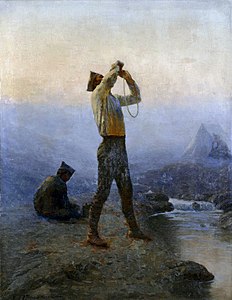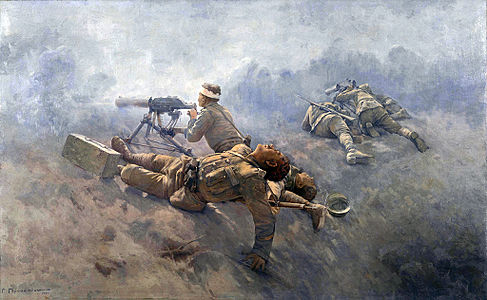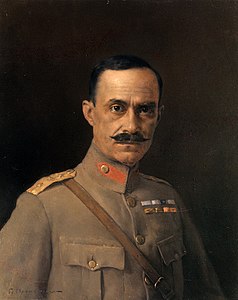Georgios Prokopiou
Georgios Prokopiou | |
|---|---|
Greek | |
| Known for | Painting |
Georgios Prokopiou (Greek: Γεώργιος Προκοπίου; 1876, in Smyrna – 20 December 1940, near Tepelenë) was a Greek war artist, photographer and documentary film maker. He also served as court painter to Emperor Menelik II and was a recipient of the Greek Military Cross.[1]
Biography
At the age of fifteen he was working as an icon painter and attracted the attention of Hortense Wood, an English artist who was living near Smyrna. She gave him drawing lessons and presented his work to Nikiforos Lytras, who recommended Prokopiou to the Athens School of Fine Arts. He enrolled there in 1895, studying with Lytras and Georgios Roilos. In 1901, after completing his studies, he returned to Smyrna and held his first exhibition. Two years later, he travelled to Alexandria and Cairo, where he painted portraits of notable figures in the Greek communities there, including Pavlos Melas, who introduced him to the head of Ethiopia's diplomatic mission.[2]

This resulted in an invitation to visit
In 1907, he returned to Athens to marry, travelled extensively, and settled in Smyrna in 1913. The beginning of
Greco-Turkish and Greco-Italian Wars

After the war, Smyrna came under
When the chaos had subsided, he was arrested and sentenced to death by a Turkish tribunal.[3] Luckily, the prison commandant allowed him to say goodbye to his family. With the assistance of his neighbors and the French Consul, he and his family were able to escape aboard a French ship that took them to Piraeus.[1] In 1925, he settled in Athens. He continued to paint military scenes from memory until 1928, after which he produced a variety of nudes, scenes of ruins and portraits, including one of Haile Selassie, who visited his studio shortly before becoming Emperor.
In 1940, the
Selected paintings
-
Soldier drinking water
-
Resting from battle
-
To the Last Man
-
Ethiopian Empress
Taytu Betul
References
- ^ a b Brief biography Archived 2014-03-11 at the Wayback Machine @ Aspromavro.
- ^ a b c Biographical notes @ To Vima.
- ^ a b c Brief Biography Archived 2008-06-03 at the Wayback Machine @ Istoria.
External links
- An appreciation of Prokopiou as a war artist @ Pemptousia. Contains the text of his letter to Metaxas.





